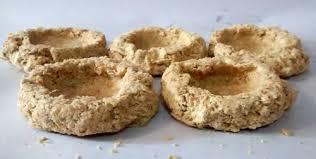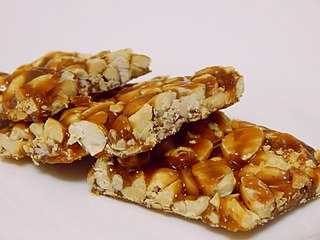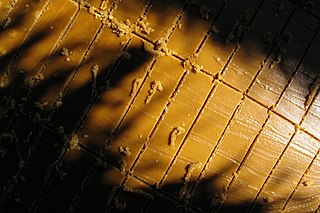
Kolhapur is a city on the banks of the Panchganga River in the southern part of the Indian state of Maharashtra.

Jaggery is a traditional non-centrifugal cane sugar consumed in the Indian subcontinent, Southeast Asia, North America, Central America, Brazil and Africa. It is a concentrated product of cane juice and often date or palm sap without separation of the molasses and crystals, and can vary from golden brown to dark brown in colour. It contains up to 50% sucrose, up to 20% invert sugars, and up to 20% moisture, with the remainder made up of other insoluble matter, such as wood ash, proteins, and bagasse fibres. Jaggery is very similar to muscovado, an important sweetener in Portuguese, British and French cuisine. The Kenyan Sukari ngutu/nguru has no fibre; it is dark and is made from sugarcane and also sometimes extracted from palm tree.
Muzaffarnagar is a city under Muzaffarnagar district in the Indian State of Uttar Pradesh. It is situated midway on the Delhi - Haridwar/Dehradun National Highway and is also well connected with the national railway network. It is known as the sugarbowl of Uttar Pradesh.

Khaja or Khajuri is an Indian deep-fried pastry, commonly filled with fruit or soaked with sugar syrup.

Rasgulla is a syrupy dessert popular in the eastern part of South Asia. It is made from ball-shaped dumplings of chhena dough, cooked in light sugar syrup. This is done until the syrup permeates the dumplings.

Muscovado is a type of partially refined to unrefined sugar with a strong molasses content and flavour, and dark brown in colour. It is technically considered either a non-centrifugal cane sugar or a centrifuged, partially refined sugar according to the process used by the manufacturer. Muscovado contains higher levels of various minerals than processed white sugar, and is considered by some to be healthier. Its main uses are in food and confectionery, and the manufacturing of rum and other forms of alcohol. The largest producer and consumer of muscovado is India.

Chandauli district is a district of Uttar Pradesh state of India, and Chandauli town is the district headquarters. Chandauli district, a part of Varanasi Division, became a separate district on 20 May 1997.

Tilkut also known as tilkutam, gajak, tilpatti, is a sweet made in the Indian states of Bihar, Jharkhand.

Chikki is a traditional Indian sweet (brittle) generally made from nuts and jaggery/sugar. There are several different varieties of chikki in addition to the most common groundnut (peanut) chikki. Each variety of chikki is named after the ingredients used, which include puffed or roasted Bengal gram, sesame, puffed rice, beaten rice, or khobra, and other nuts such as almonds, cashews and pistachios.

Sugarcane or sugar cane is a species of tall, perennial grass that is used for sugar production. The plants are 2–6 m (6–20 ft) tall with stout, jointed, fibrous stalks that are rich in sucrose, which accumulates in the stalk internodes. Sugarcanes belong to the grass family, Poaceae, an economically important flowering plant family that includes maize, wheat, rice, and sorghum, and many forage crops. It is native to New Guinea.

Kakinada Kaja is a traditional sweet pastry from Kakinada in Andhra Pradesh, India, known for its unique taste and preparation. It comes in two main varieties: the hollow, cylindrical Gottam Kaja and the layered Madatha Kaja, each offering distinct textures and flavours. The dessert holds significant cultural importance in Andhra Pradesh, with efforts underway to obtain a Geographical Indication (GI) tag to preserve its legacy. Along with the related Tapeswaram Kaja, it remains a beloved delicacy throughout the Telugu states.
Dhindhwali is a village in Muzaffarnagar district, Uttar Pradesh, India. Its total population is 6,267,. It is located 120 km from the national capital New Delhi. Dhindhawali village is also situated near the Titawi Sugar factory, which is 6 km to the south. It was once famous for "Nakchunti" and "Gud".The main corps is sugar cane. There are mostly jats(jatts) in this village. kutba and nunakhera are nearby villages.hookah is most popular in the village. Baliyan(surname) is the main surname of jats.

Non-centrifugal cane sugar (NCS) is the technical name given to traditional raw sugar obtained by evaporating water from sugarcane juice. NCS is internationally recognized as a discrete and unique product by the FAO since 1964 and by the World Customs Organization (WCO) since 2007. WCO defines NCS as "cane sugar obtained without centrifugation". It also states that "the product contains only natural anhedral micro-crystals, of irregular shape, not visible to the naked eye, which are surrounded by molasses' residues and other constituents of sugar cane". NCS is produced in most sugarcane-growing regions of the world, being known by many different names such as panela, jaggery, or gur. Some varieties of muscovado are non-centrifugal.

The Kolhapur jaggery is a variety of jaggery made from fresh sugarcane juice in the Indian state of Maharashtra. It is an agri-product manufactured from sugarcane which is a common and widely cultivated crop in Kolhapur. The waters of the streams forming the Panchganga river are primarily used for sugarcane cultivation in Kolhapur. It is also the most exported variety of jaggery from India.
The Central Travancore jaggery is a variety of jaggery made from fresh sugarcane juice in the Indian state of Kerala. It is an agri-product manufactured from sugarcane which is a common and widely cultivated crop in Kottayam and Pathanamthitta Districts and Chengannur taluk in Alappuzha District. The riverbanks and nearby places of Pamba, Manimala, Achenkovil and Meenachil rivers are primarily used for sugarcane cultivation in the region.
The Marayoor jaggery is a variety of jaggery made from fresh sugarcane juice in the Indian state of Kerala. It is an agri-product manufactured from sugarcane which is a common and widely cultivated crop in Marayoor and Kanthalloor Grama panchayaths of Devikulam taluk, Idukki district grown particularly by the farmers of Muthuva tribe.

Khejurer Gur is a type of jaggery made from date palm sweet sap. The sap is boiled and concentrated to syrup phase by evaporation; gur (jaggery) is prepared by cooling the concentrated syrup. Khejurer Gur is available in two forms — patali (solid) and nolen or jhola (liquid). The word Khejur generally refers to the Date palm while the word Gur refers to jaggery.
Adamchini Chawal is a variety of non-Basmati, traditional, short-grained aromatic rice mainly grown in the Indian state of Uttar Pradesh. It is a common and widely cultivated crop in Chandauli, Mirzapur, Varanasi and Sonebhadra, and Vindhya region of Eastern Uttar Pradesh.